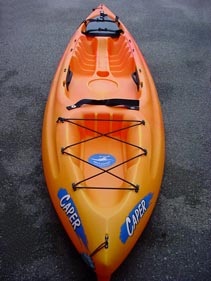Ocean Kayak Caper
At just 11 feet (3.3m) long and 45lbs (20.4kg) the Caper is short and light by fishing kayak standards. Constructed from linear, medium density polyetheylene the Standard Caper as tested here is available in ten different colours, ours being Sunset. The Angler version complete with flush mount rod holders and heavy duty fittings is available in two colours. The maximum weight capacity of both models is 275-325lbs (124.7-147kg) depending on sea conditions.

The top side of the hull has a large deep moulded tankwell with two self-bailing scupper holes for drainage, an elasticated bungee is provided to contain larger items. Directly in front of the tankwell is the moulded seat with a width of 31" (78.8cm) and two scupper holes to the rear, an aftermarket seat with accessory bag is fitted to our Caper which is a must if you intend to spend much time paddling or fishing, this is attached via the webbing straps directly behind the seat area which clip onto the rear of the seat, from the back rest two straps then fix to the kayak accessory eyes at the front via brass snap links.
Immediately in front of the seat is a circular recess to accommodate the optional 6" screw in hatch with cat bag, it's worth noting that this bag is not a dry bag, and the hatch may let in a very small amount of water, so vulnerable items will need to be kept in waterproof containers if placed inside. Around the top edge of the cockpit are eight accessory eyes, four on each side.
Forward of the hatch is a cupholder!
A flatish area runs from the cupholder up to the raised front deck, either side of which there are a set of moulded-in footwells giving a comfortable paddling position. Two more scupper holes are set in front of the last set of footwells.
The raised deck is where the large hatch is placed, this has a drainage channel running around its circumference and two heavy duty straps with plastic spring clips holding the lid in place, the lid is permanently attached to the bow with a third strap. This hatch allows access inside the hull, extremely useful for storing rods and reels on a return journey through the impact zone, although it would not be wise to open the hatch in a heavy sea as this could cause flooding of the hull and possible sinking. The hatch does let in a very small amount of water, approximately a dessert spoonful on the average outing. Clothes or valuables should be stored in a dry bag before placing inside the hull.
And finally at the tip of the bow there is a screw-in drain plug.
Below the waterline the tri-form hull consists of a smooth rounded keel running fore and aft with shoulders on either side, these shoulders give the Caper it's secondary stability.
For transporting there are four carrying handles one moulded grab handle at each end and a looped handle either side of the seat area.
The Caper balances easily on the shoulder when carried over a short distance.
Launching could not be easier, tow the kayak into the water until your knees are wet and climb aboard, either sitting sideways and swinging your legs into position or just stepping lightly onboard, keeping your weight over the centre of the kayak, immediately you notice just how stable the Caper is.
Once on the water the kayak handles well, it tracks in a straight line and turns easily, helping to give the inexperienced paddler confidence. The ride is very smooth with a slightly audible slapping from the bow, this has been cured by fixing the fishfinder battery inside the forward hatch.
Making your way out through the surf is an easy affair, the Caper riding up over the incoming waves, the return journey however can be a little breathtaking. In larger surf the nose does try to bury itself and the kayak will attempt to turn along the wave followed by a quick roll and rinse for the unwary. Far better to plan your return to the beach and paddling fast on the back of a wave.
Paddling any Sit-On-Top can be a wet affair, water runs off the paddle and splashes over the bow in a swell, the Caper's footwells do fill up and the water does not easily drain away as the scupper holes are parallel with the water line, but what little water reaches the seat area drains as it is that much higher. Scupper plugs can be fitted in the footwell scupper holes which will help provide a much dryer journey especially useful in the colder months.
When at rest the Caper remains stable, allowing considerable body movements when casting or reaching for items placed around the cockpit and tankwell. Whilst fishing I prefer to sit sideways with my legs over the side, this position allows easy access to the well drained tankwell which contains my tackle and bait. Using the forward hatch when at sea is a little harder and is only for the experienced kayaker in calm conditions, you will need to shift your weight forward which causes the Caper to become a little tippy as your weight is placed over an area where the hulls shoulders are less prominent and there is less volume, the bow also becomes very low in the water, hence the reason why this should only be attempted in calm conditions.
Overall the Caper is a compact, light, well built and easy to use kayak, equally ideal for the first time paddler or experienced kayakfisherman or woman.
